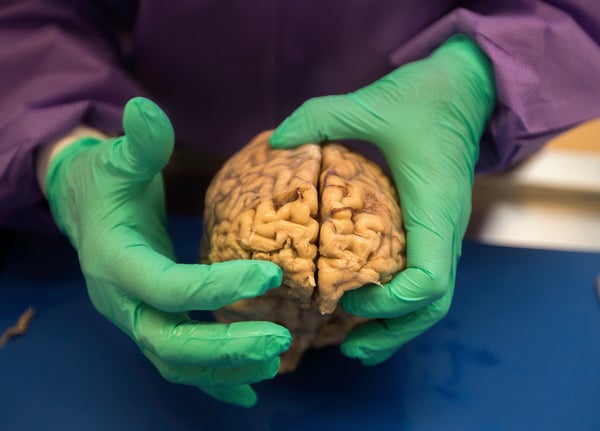The controversy began about 10 years ago, when it emerged that the National Football League had first tried to cover up evidence linking repetitive head injuries in players to chronic traumatic encephalopathy (CTE), a progressive neurodegenerative disorder, and then to discredit the scientists doing the work. Since then, evidence supporting this link has grown as an increasing number of players have come forward to report that they are suffering from depression, and some have committed suicide. And yet exactly how repetitive head injuries are linked to CTE development and the psychiatric symptoms associated with it is still a matter of debate.
The largest ever study of its kind has now given the most compelling evidence yet linking repetitive head impacts in football players to CTE. The study, published recently in JAMA, has notable limitations, however. It has also sparked calls for more research to measure the impact of head blows on players over the course of a lifetime.
The new work builds on findings from 2013: neuropathologist Ann C. McKee of Boston University and her colleagues published a postmortem report of 68 male athletes and military veterans with CTE, in which they described a spectrum of pathological signatures associated with the condition. McKee and her colleagues observed two distinct sets of clinical symptoms: one involving disturbances in mood and behavior, which was seen in the younger subjects, and the other including cognitive impairments, which developed at an older age.
On supporting science journalism
If you're enjoying this article, consider supporting our award-winning journalism by subscribing. By purchasing a subscription you are helping to ensure the future of impactful stories about the discoveries and ideas shaping our world today.
Based on its findings, the team proposed a number of pathological criteria for the diagnosis of CTE, similar to those for Alzheimer’s disease. Their proposal also identified stages by which these pathologies and the behavioral symptoms associated with them become more severe with time. According to the criteria set out by the researchers, early symptoms of CTE include headaches and attention deficits, progressing later to depression and short-term memory loss, then to cognitive impairments and finally to full-blown dementia and aggression.
In this latest study, the researchers examined the brains of 202 deceased football players, all of which had been donated to a brain bank created to investigate the long-term effects of repetitive head injuries in athletes, military personnel and victims of domestic abuse. They obtained detailed medical histories for all the subjects, measured the volume of their brain and then dissected the organ to look for CTE-related neuropathology.
Of the 202 participants examined in the study, 177 were diagnosed with CTE, based on the previously described pathological characteristics. They had an average of 15 years of experience with the game, at the high school, college or professional level. Their median age of death was 67 years, with the most common causes being neurodegenerative disease (39 percent), cardiovascular disease (19 percent) and suicide (10 percent). The severity of CTE pathologies was associated with the intensity of play, with all the former high school players exhibiting mild CTE pathology and more than half of the former college, semiprofessional and professional players exhibiting severe pathologies.
Behavioral and mood symptoms were common in all the former NFL players diagnosed with CTE, having occurred in almost all the 26 individuals with mild pathology and 75 of the 84 individuals with severe pathology. Other common symptoms included anxiety, depression and impulsivity. Verbal aggression, physical violence, suicidal thoughts and substance abuse had also occurred in the majority of those with mild CTE pathology, but post-traumatic stress disorder was uncommon, occurring in only three cases with mild pathology and nine cases of former players who were more severely affected.
Despite the high proportion of study participants exhibiting CTE pathology, the authors urged caution in interpreting their results. One important limitation of the study is the biased sample—brains that were donated for the specific purpose of examining links between head trauma and CTE. It does not necessarily follow that the frequency of CTE in the wider population of people exposed to repetitive head injuries is as high as that found in the study. Nor is the sample representative of the overall population of football players, most of whom play only on youth or high school teams. “Our sample has very clear ascertainment bias,” says study co-author Bobby Abdolmohammadi, a research assistant in McKee’s laboratory. “That is, families may have been motivated to donate the brains of their loved ones because they saw symptoms or were aware of the link between repetitive head trauma and football, [so] we can’t jump to any conclusions about the frequency of the disease in the general population or among football players at this point.”
Abdolmohammadi adds that determining the precise nature of the relationship between repetitive head injuries and CTE would require well-designed longitudinal studies. Such research may finally begin to determine the true impact of repetitive concussion on brain structure and function.
Still, experts say the new findings are striking. “This is an extremely important and convincing piece of work, [which] leaves no doubt that there is a serious issue in American football,” says John Hardy, a professor of neuroscience at University College London, who was not involved with the study. “We now have very good evidence there is a problem..., which needs to be addressed immediately in terms of rule changes to reduce head contact if the sport is to survive.”
Hardy acknowledges that the new results do not determine the extent of the problem, however. “As the authors are clear in pointing out, the cases were selected based on clinical suspicion of CTE,” he says, adding that a broader effort is now needed. Hardy calls for more studies of both active and retired players that look for acute evidence of brain damage using scans and by measuring possible damage in blood and cerebrospinal fluid. “We need systematic data to understand how big the problem is,” he says.
